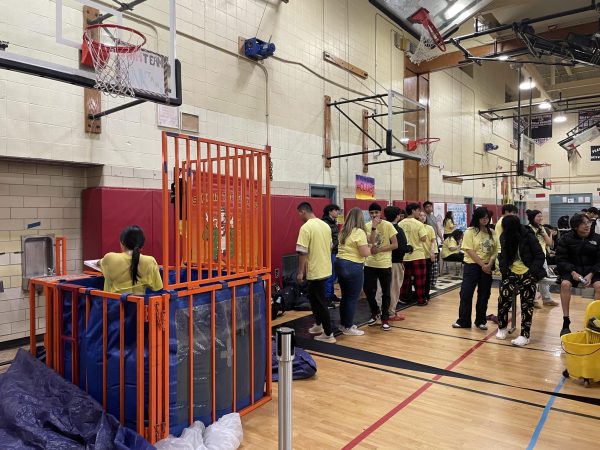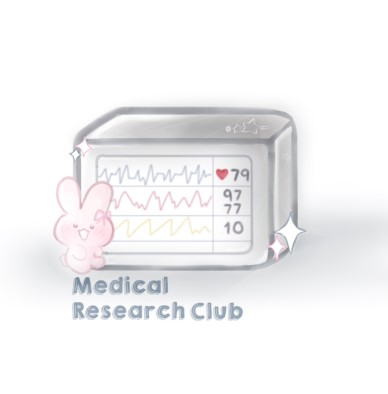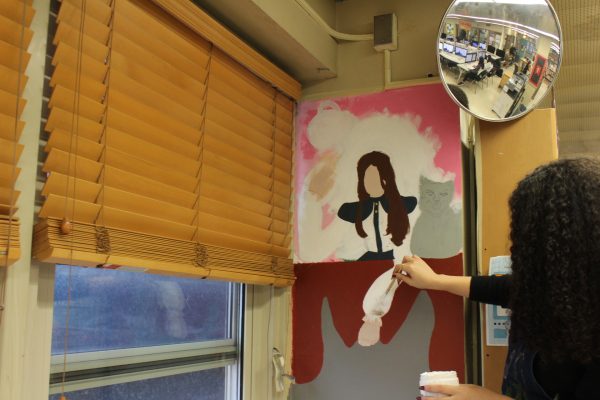An Ever Growing Population: Francis Lewis and Overcrowding
The halls are tranquil. Those who are released early speak in hushed tones and wait patiently by the door of their classroom. Gentle murmurs and the occasional creak of the double doors are the only audible sounds. The calm before the storm.
The silence is interrupted by a harsh, grating noise— desks scraping against the tiled floor. Not long after, the bell sounds and students begin pouring from each door, quickly filling the hall. All that is visible is a sea of students and everyone is packed tightly against each other like sardines, incapable of moving but one inch at a time.
“It’s like an ambush, it’s extremely overwhelming,” said Elaine Riche, a teacher at Francis Lewis High School. “If I waited until the bell rang to get to my class, I would not be able to get to my own class on time and navigating the hallway is just an extremely overwhelming experience.”
Ms. Elaine, along with members of the student body, teachers, and staff, must deal with the ever-growing amount of individuals in the halls of Francis Lewis on a daily basis. A majority of individuals feel that the school’s large population makes it difficult to navigate through the halls of Francis Lewis and negatively impacts the overall learning experience.
Why So Many Students?
Francis Lewis was originally designed for 2,100 students, as stated by James Vasquez who is a Representative of the United Federation of Teachers. With a population of over 4000 students and counting, Francis Lewis is one of the most heavily overpopulated schools and, as of last year, the number one most applied to in New York City.
Francis Lewis is considered to be a highly profiled community high school with numerous programs, a high college readiness index, and diverse population. These factors can lead to a great increase in enrollment, in turn increasing overcrowding. However, students cannot enroll into the school unless the student lives in the neighborhood and is a part of the zoned program, lives out of the neighborhood and is a part of a screened program, is a part of the Public School Choice Program, or the student has a disability and is eligible to attend the school if the school does not have enough students with disabilities.
How Does This Impact Students and Staff?
Transitioning from one period to another may prove to be difficult for teachers and students alike, but arriving late to class can result in more than being marked as tardy. Teachers who arrive late to their own class have less time for instruction, which also impacts the grades of students. The amount of latenesses a student gains accumulates over time, which can lead to phone calls home, less instruction, and a lower grade.
In some instances, students may even become impatient and lose their temper in the halls.
“There has been times when I’ve seen fights happen because there is so much shoving,” junior Kasondra Moran said. “People are yelling, complaining, and it can be chaotic. “I feel the school as a whole is overcrowded, but the second floor is always packed with students making people late to their second floor classes.”
For students that are familiar with the school, navigating the halls can be more simplified in knowing what areas to avoid and what routes are best to take when travelling to their next class. However, first year students that are not as knowledgeable are faced with the challenge of familiarizing themselves with the school and dealing with overcrowding in the process.
“This school is super crowded, I can’t even get to class on time most of the time,” said freshman Emily Chen. “In my old school it was so much different because it was crowded, but you could actually walk through to get to class on time.”
Increase Overtime
Throughout the 2000’s there has been an increase in the population, often ranging from around 3000 or higher. Just last year, over 9000 students attempted to enroll into the school, but overcrowding dates back even farther than the 2000’s.
“The hallways were very congested and you couldn’t deviate from your route,” said Andrew Eisenstadt, Class of 1971. “You had to be focused on where you were going and you couldn’t really stop and talk or have water. You had to be responsible for the times you had to be where you had to be.”
With a difference of twenty-six years, the population only continued to increase.
“The overcrowding in this school is getting out of control,” said Katharine Andriotis, teacher and Class of 1997. “I do remember it being overcrowded twenty years ago but I don’t think to this extent.”
A Solution
Students and teachers have similar suggestions to solve overcrowding in the school. Many proposed that accepting less students and increasing time in between passing would resolve the issue. However, increasing time in between passing would lead to less time for tutoring and accepting less students leads to further complications.
“We care about our kids,” said Principal Dr. Marmor. “If we started cutting out hundreds of kids with excellent grades, it would have an impact on the school’s culture. We cannot cap enrollment, so there is no way to stop enrollment.”
____________________________________________________________________________
Additional reporting by Jonathan Wong and Ji Li












